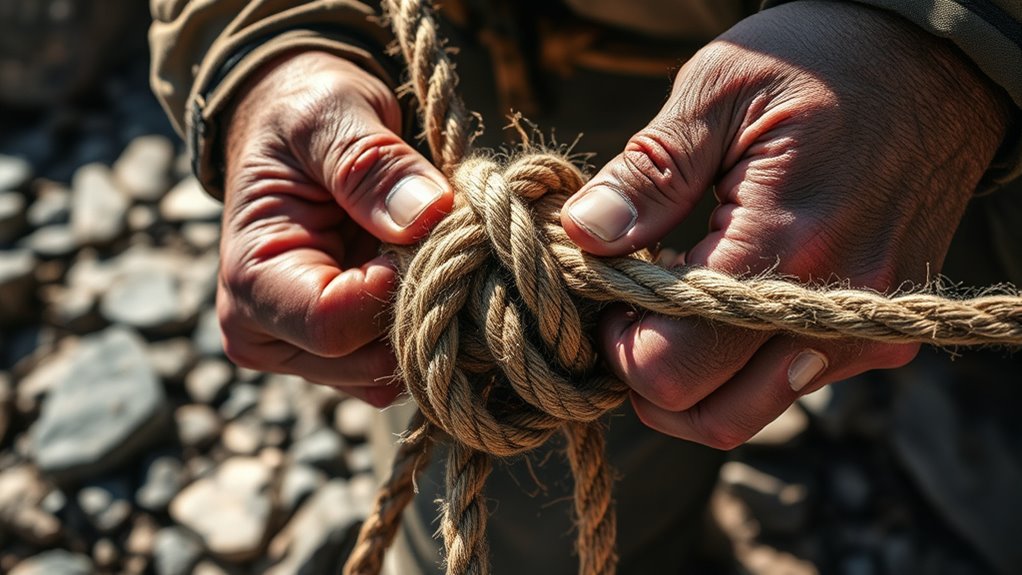Knowing essential survival knots like the bowline, sheet bend, halter hitch, and clove hitch lets you build shelters, secure gear, and perform rescues confidently. Mastering their techniques guarantees your lines stay secure under tension and are easy to untie when needed. Proper practice with durable materials helps reinforce your skills and confidence in high-pressure situations. If you keep exploring, you’ll discover detailed steps and tips to become adept at knot tying for any survival scenario.
Key Takeaways
- Master essential knots like the Bowline, Sheet Bend, and Clove Hitch for shelter, gear, and rescue needs.
- Learn proper knot techniques, including dressing and securing, to ensure safety and reliability under stress.
- Practice with durable materials such as paracord to build confidence and muscle memory.
- Use additional security methods like half hitches or stopper knots to prevent slipping.
- Study advanced knots like the Prusik and Water Knot for specialized survival applications.
Essential Survival Knots to Know
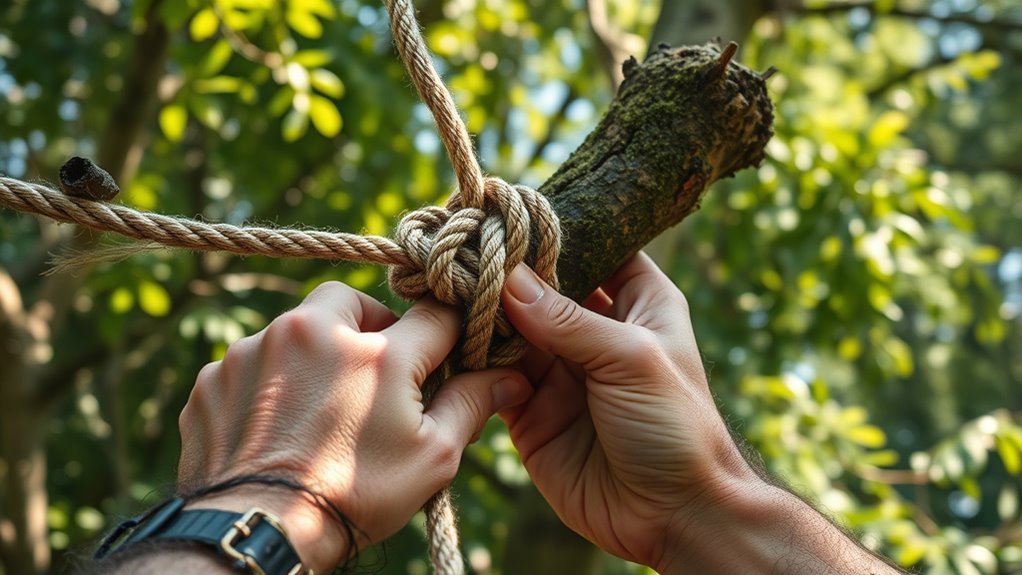
Mastering essential survival knots is important because they enable you to build shelter, secure gear, and perform rescues efficiently. The Bowline creates a reliable, non-slipping loop you can easily untie after tension, perfect for rescue or securing a line around a post. The Sheet Bend effectively joins two lines of different diameters, making it ideal for extending lines or crossing rivers. The Halter Hitch tightens around objects, providing a quick-release hold for securing gear or shelter lines. Recognizing and practicing these knots—Bowline, Sheet Bend, and Halter Hitch—are key skills, especially when working with a line or tying a loop. Regular practice with durable materials like paracord helps you master these knots, ensuring you can quickly and confidently secure, untie, and manage your gear in any survival situation. Additionally, understanding the importance of quality materials] can be valuable for long-term resilience during emergencies.
Basic Knot Terminology and Techniques
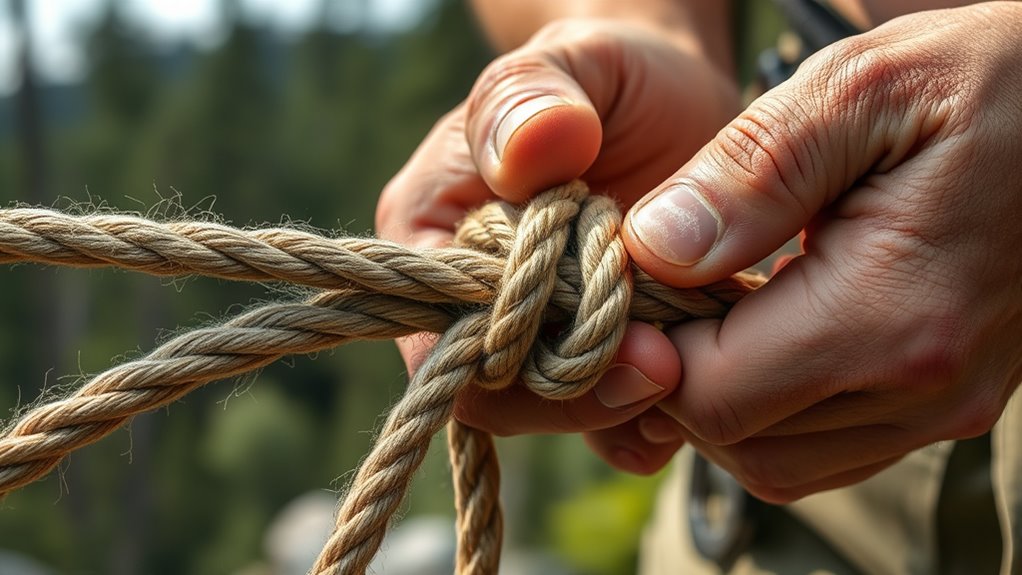
Understanding basic knot terminology and techniques is vital for tying effective and secure knots. The working end, or bitter end, is the active part you manipulate to form the knot, while the standing end remains stationary. A bight is a loop created by folding the rope without crossing the ends, useful for forming secure knots or fixed loops. To achieve well-dressed knots, you should arrange the knot neatly, applying even tension to prevent twists and ensure proper formation. Always leave enough tail—at least three to four rope diameters beyond the knot—for safety. Proper technique involves consistent hand movements and maintaining tension as you dress the knot, ensuring a secure loop or knot that holds under load. Recognizing different knot types and their specific uses enhances your overall knot-tying knowledge, which is essential for reliable knot tying. Developing a good understanding of sound principles of tension and friction can further improve your knot security. Incorporating regular practice and review into your knot-tying routine helps reinforce proper techniques and builds confidence, ultimately leading to more dependable knots. Additionally, understanding proper material selection can improve knot security and performance based on the type of rope used. This foundation is vital for reliable knot tying.
How to Tie a Bowline for Secure Loops
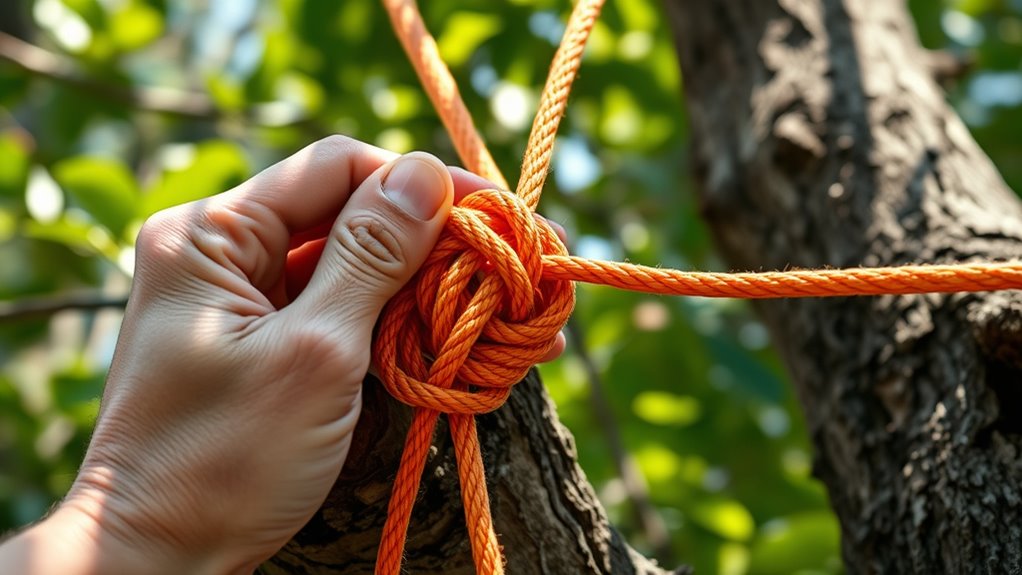
To tie a dependable bowline for secure loops, start by forming a small loop in the rope with the working end on top of the standing part, creating the initial bowline shape. Next, pass the working end up through the loop from underneath, forming the “rabbit’s ear.” Wrap the working end around the standing line from left to right, then bring it back down through the original loop. Pull the working end to tighten the knot, ensuring it’s snug and secure. This bowline creates a strong, stable loop perfect for rescue, shelter lines, or attaching gear. Its reliability under load makes it a crucial knot for survival situations, as it stays secure even if the rope is tugged or loaded heavily. Additionally, knowing how to tie a bowline is essential for creating secure loops that won’t slip or come undone under stress.
Mastering the Double Sheet Bend for Joining Ropes

The Double Sheet Bend offers a more secure way to join two ropes, especially when they differ in size or material. It creates a slip-resistant, strong connection that’s ideal for critical situations. To tie it, form a bight with the thicker rope, pass the thinner line through, then wrap it around the standing part twice before tightening. Proper tension and long tag ends help the knot stay secure under load and make it easier to untie later. This knot excels in emergency line extensions, tarp rigging, or rescue scenarios. Its strength ensures your ropes stay joined even when tension increases. Additionally, understanding asset division strategies can help ensure your resources are managed effectively after such scenarios. Recognizing the importance of sustainable foraging can also contribute to maintaining safe and reliable supplies of natural resources in survival situations. Regularly inspecting your gear for wear ensures that your cycling equipment remains dependable in emergencies. Being familiar with various knot types can further improve your preparedness and safety in survival situations.
Securing Lines With the Halter Hitch

When you need a reliable way to temporarily secure a line around an object, the Halter Hitch is an excellent choice because it tightens under tension and is easy to adjust or release. This friction knot is perfect for securing lines in survival situations, providing knot security while remaining adjustable. Its design allows it to hold firm under tension, making it a useful survival knot for temporary fastening. To tie a halter hitch, form a bight around the object, then create a second bight with the tail, maintaining tension to lock the knot in place. It’s quick to release by pulling the free end or relaxing tension. For added security, you can combine the halter hitch with a half hitch or wraps, ensuring a dependable, adjustable fastening in any emergency. Additionally, understanding the importance of knot security and proper techniques can improve your overall safety and efficiency when using this knot. Knowing how knot types and their specific uses can further enhance your knot-tying skills in survival scenarios. Practicing different knot configurations can help you adapt to various situations and improve your confidence in critical moments.
Common Clove Hitch Applications and Tying Methods
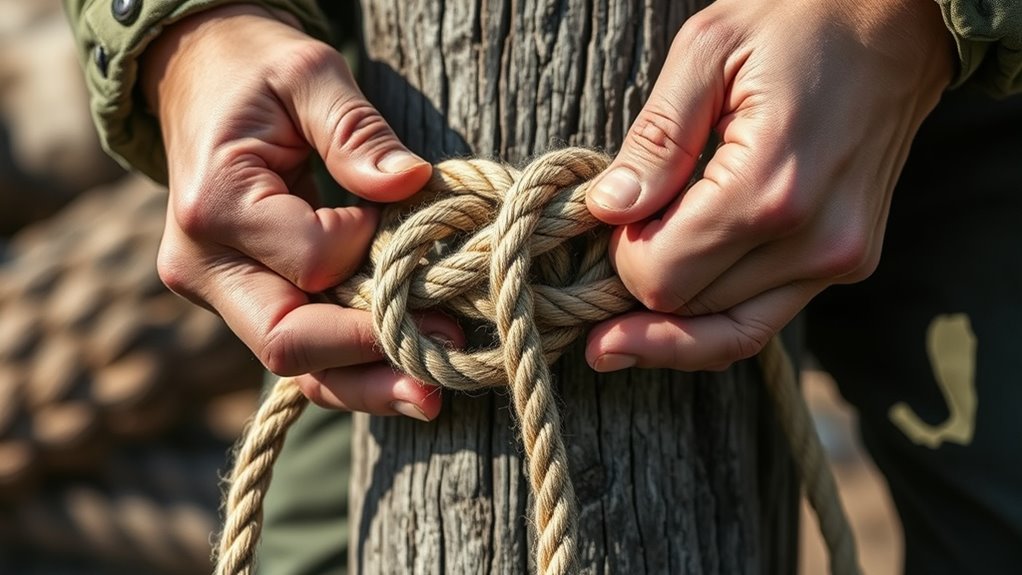
The clove hitch is a versatile knot you can use to attach ropes around poles or trees quickly. It’s essential to know how to tie it properly to prevent slipping or shifting under tension. Using additional securing knots can help guarantee your setup stays reliable in survival situations. Proper installation and maintenance of your knots ensure they remain effective over time. Additionally, understanding the properties of essential oils for various health concerns can support overall wellbeing during outdoor activities. When working with synthetic materials, choosing the right heat settings is crucial to avoid damaging your gear or compromising safety. Moreover, selecting a vacuum with high suction power can significantly improve cleanup efficiency in rugged outdoor environments. Being familiar with Rhythm Failure can also provide inspiration for creating motivating routines during outdoor training or survival drills.
Tying Around Poles
Tying around poles with a Clove Hitch offers a quick and reliable method to secure ropes for various survival applications. To do this effectively:
- Wrap the rope around the pole twice, crossing over each time, forming two loops.
- Tuck the working end under the last wrap, creating a knot that holds the tension.
- For added security, finish with a half hitch or stopper knot to prevent slipping. Proper tension and knot dressing are crucial for knot stability, correct technique, and safety during use. Additionally, understanding basic knot principles can help you adapt this knot for different scenarios. This method ensures the Clove Hitch is well-dressed and tight, securing the rope around the pole. Adjust the loops to tighten or loosen as needed, and make sure the end is secured to avoid slipping under tension. Whether supporting a shelter or securing tools, this knot is versatile for any pole-based task.
Preventing Slips and Shifts
To prevent slips and shifts in your Clove Hitch, it is vital to secure it properly after tying. A loose knot can easily slip, especially on smooth or round surfaces, reducing stability under load. To add friction and prevent slipping, wrap the line around the object multiple times before completing the knot. Dressing the knot correctly ensures it stays snug and maintains tension. For added security, tie two half-hitches or add a stopper knot after the Clove Hitch, which can considerably prevent shifts during critical tasks. In high-tension situations, consider using more secure alternatives like the Taut-Line Hitch. These methods help keep your knot secure, preventing unwanted movement and ensuring reliable support when it counts most.
Secure Temporary Attachments
Using a Clove Hitch is a quick and effective way to attach ropes to round objects like poles, trees, or posts, making it ideal for temporary setups such as shelter frames or gear supports. To secure your attachment, follow these steps:
- Wrap the rope around the object twice, crossing the wraps.
- Pass the working end under the last wrap.
- Tighten the knot for a secure hold.
This knot is adjustable and easy to reposition, but it can slip under heavy load. For a more reliable temporary attachment, consider adding a half hitch or another knot. The Clove Hitch’s quick tying and untying make it perfect for fast, temporary needs, ensuring your gear stays in place when you need it most.
Additional Knots for Advanced Survival Situations
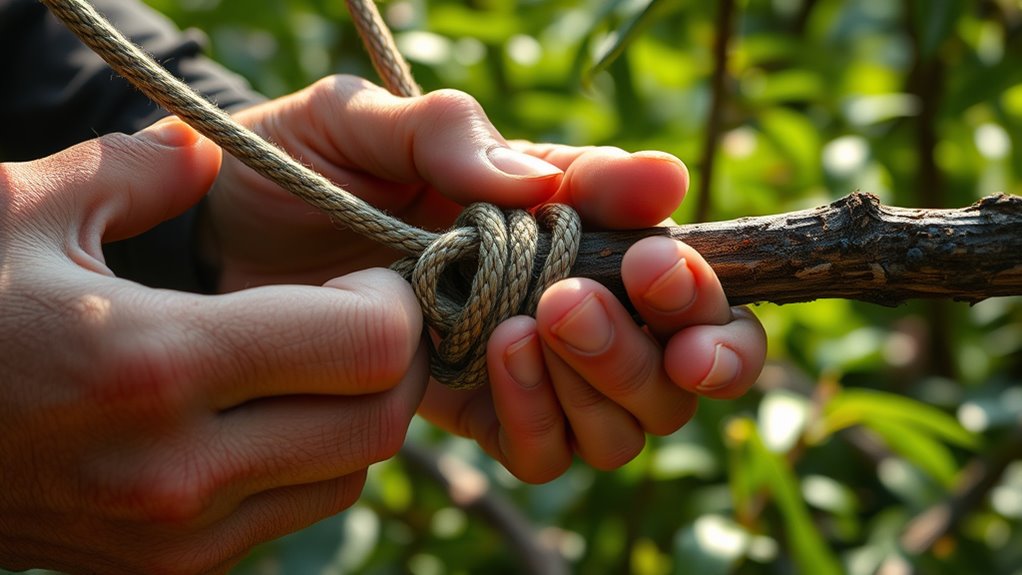
In advanced survival situations, knowing a variety of specialized knots can be crucial for ensuring safety and effectiveness. The Double Fisherman’s Knot provides a strong, secure bend, perfect for joining ropes of different diameters in rescue or climbing. The Prusik Knot acts as an adjustable, slidable loop, allowing you to ascend or descend while maintaining grip under load, essential for rescue operations. The Water Knot is designed for webbing or straps, offering a reliable, non-slip connection that maintains strength under tension, ideal for slings or gear. The Rolling Hitch enables you to secure or extend lines with adjustable tension, making it indispensable for tensioning rescue ropes or hooking onto sled lines. Mastering these knots ensures your gear remains secure, reliable, and ready for demanding survival scenarios.
Practice Tips to Improve Your Knot Skills
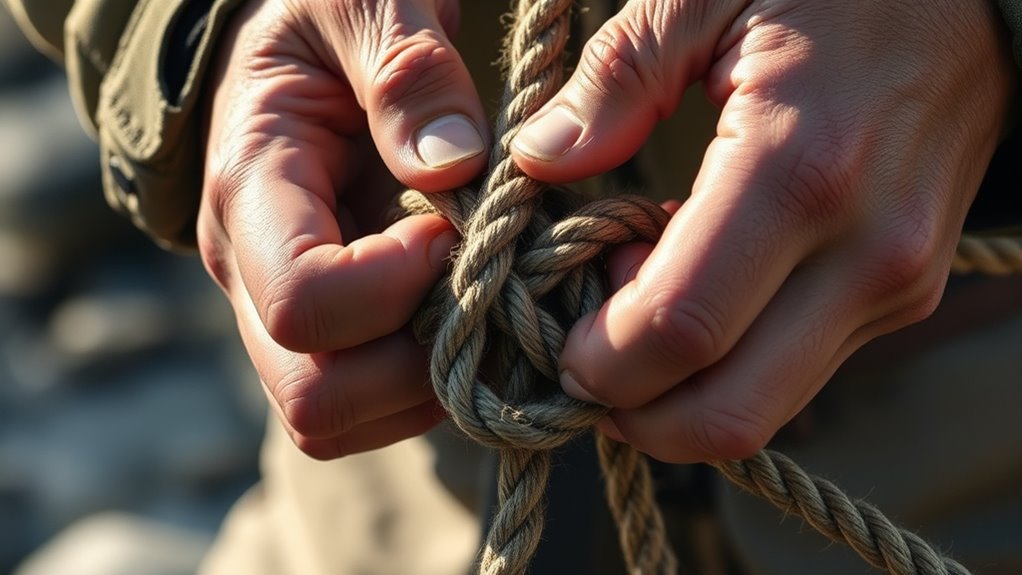
To sharpen your knot skills, establish a regular practice schedule to build muscle memory and confidence. Use durable materials like paracord or nylon to mimic real-life situations and challenge yourself in different conditions. Study instructional videos and diagrams often to guarantee you’re applying correct techniques and avoiding common mistakes.
Regular Practice Schedule
Establishing a consistent practice schedule is essential for mastering survival knots. By dedicating regular time, you reinforce technique, build muscle memory, and boost confidence. To maximize your progress, consider these steps:
- Practice for at least 10 minutes daily, focusing on knots like the Bowline, Sheet Bend, and Clove Hitch to improve repetition and technique.
- Vary your practice by using different rope materials and diameters, preparing you for real survival scenarios.
- Record your sessions to identify mistakes, track improvement, and refine your training over time.
A structured schedule ensures steady progress, makes learning more effective, and keeps your skills sharp for any survival situation. Consistency is crucial to transforming practice into reliable knot-tying mastery.
Use Durable Materials
Using durable materials like seven-strand 550 paracord is vital for developing reliable knot-tying skills. High-quality, high-strength ropes like paracord help you understand material behavior and how different ropes affect knot security. Practicing with durable materials improves rope durability and guarantees your knots for survival hold under stress. Focus on dressing and tightening knots properly, which is essential for maximum reliability. Incorporate exercises with quality ropes into your routine to build muscle memory and confidence. Visual knot tutorials and diagrams can help you grasp techniques and adapt to various material behaviors. Remember, practicing with the right materials not only enhances your skills but also prepares you for real-world scenarios where knot security and rope durability are critical.
Study Visual Resources
Studying visual resources is a highly effective way to enhance your knot-tying skills. Using animated knot tutorials from reputable sources like Grog’s website helps you visualize each step clearly. To improve tying techniques and reliability, consider:
- Watching animated knot tutorials to master proper dressing and tying methods.
- Practicing tying knots multiple times in realistic scenarios, such as outdoors around trees or posts, to build muscle memory.
- Recording yourself on your phone for knot review, which helps identify errors and guarantee consistent, proper technique.
Incorporating these visual resources into your training allows you to develop confidence and adapt to different conditions. Regular outdoor knot practice and knot review solidify your skills, ensuring your knots perform reliably when it matters most.
Resources for Learning and Practicing Knots
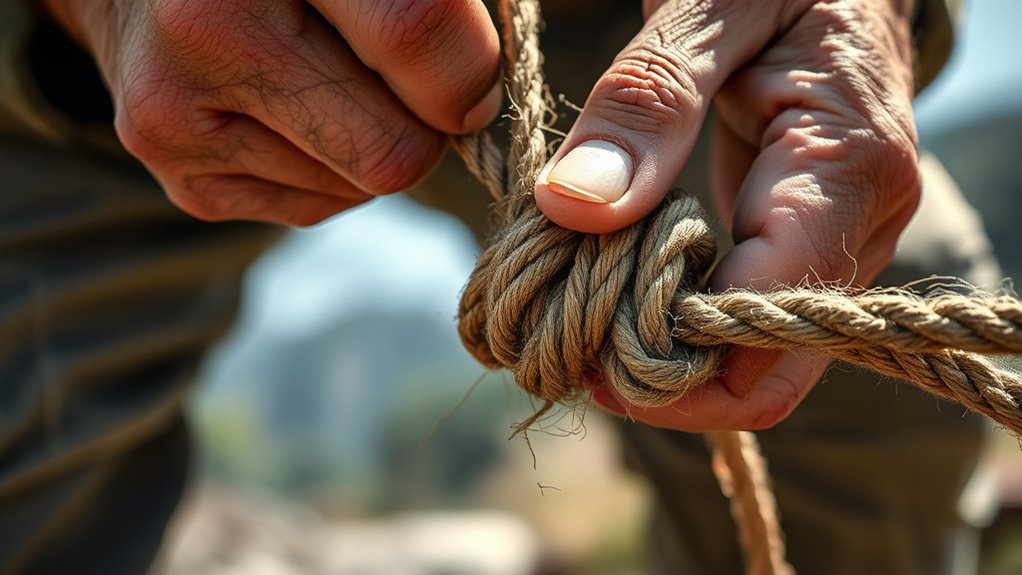
To master knot tying for survival, acquiring high-quality resources that make learning both effective and engaging is essential. Using animated knot tutorials from Grog and online platforms helps you visualize proper knot-tying techniques, building muscle memory. Refer to trusted sources like Wikipedia and Caves.org for detailed explanations of knot terminology, safety considerations, and strengths. Regularly practice tying survival knots such as the Bowline, Sheet Bend, and Clove Hitch with durable paracord materials from suppliers like 5col. Joining knot-tying workshops and online forums offers hands-on experience and feedback. Here’s a quick overview:
| Resource Type | Benefits | Examples |
|---|---|---|
| Video Tutorials | Visualize techniques, build muscle memory | Grog’s animated tutorials |
| Written Guides | Understand knot terminology and safety | Wikipedia, Caves.org |
| Hands-On Practice | Reinforce skills, test knots in real scenarios | Paracord practice with 5col |
Frequently Asked Questions
What Is the Best Knot for Survival?
The best knot for survival is the Bowline. You can quickly tie it with one hand, and it creates a secure, non-slipping loop that’s easy to untie even after heavy load. Its reliability makes it perfect for rescue, shelter, or hauling. When you need a dependable loop in emergencies, the Bowline is your go-to knot because it maintains strength and shape under pressure.
Why Is Knot Tying Important in Survival?
You realize that knot tying is essential because it helps you create reliable solutions quickly, especially in emergencies. By mastering key knots, you can build shelters, secure gear, and perform rescues confidently. It saves space and weight by replacing bulky hardware and guarantees safety under stress. Knowing how to tie the right knots enhances your problem-solving skills and boosts your confidence, making you better prepared to handle unpredictable survival situations.
Which Knot Is Used for Life Saving?
Did you know that over 80% of rescue operations rely on the Bowline knot? It’s the go-to for life-saving because it creates a secure, non-slip loop that’s easy to tie and untie even under load. You’ll find it essential for securing harnesses, rescue loops, and anchor points. Its reliability and quick-release feature make it the safest choice when lives are on the line, ensuring a swift and secure rescue.
How Do You Tie a Death Knot?
To tie a death knot, start by overlapping the two ropes and wrapping each around the other twice. Pass the ends through the loops you’ve created and pull tight. Make certain you leave at least 3-4 inches of tail to prevent slipping. Practice this knot regularly with different ropes so you can tie it quickly and confidently in emergencies, knowing it’s secure and reliable when needed most.
Conclusion
Mastering survival knots boosts your confidence, secures your shelter, and saves your life. Practice tying, perfect your techniques, and understand each knot’s purpose. Keep learning, stay prepared, and stay safe. Whether securing gear, building shelter, or signaling for help, your knot skills make all the difference. Stay diligent, stay confident, and keep knotting—because in survival, your skills are your greatest asset.

